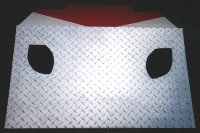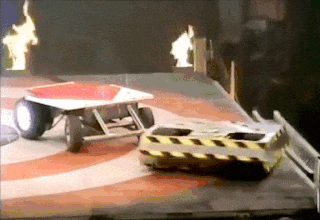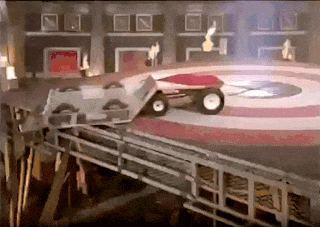 Run Amok at Robotica
Run Amok at Robotica
Frequently Asked Questions from the first season of Robotica
Privacy Policy
Q: Not many other Robotica teams chose "automotive" style steering for their 'bots. Why did you decide to use steering front wheels and what are the advantages and disadvantages of that design?
A: Most 'bots use "tank steering", the method that military armored tanks use to change direction. In tank steering, the wheels (or treads) on one side of the vehicle are made to turn at a different speed than the wheels on the other side. This makes the vehicle move in an arc rather than a straight line. For very tight turns, the wheels on one side can be stopped or even reversed with respect to the wheels on the other side. These vehicles can turn within their own length. Advantages of this system are maneuverability in very tight quarters and great structural strength because the wheels may be very firmly mounted without the need to pivot. Disadvantages include difficulty turning smoothly and accurately when running at speed.
Run Amok steers just like a car; the front wheels turn to guide its path. Because of its very short wheelbase, Run Amok can still turn very tightly. My experience in operating remote controlled vehicles with automotive style steering led me to this design. I knew that it would be much easier to drive the figure-8 course and to accurately drive the straight sections of the Maze and the Gauntlet with front-wheel steering. I did sacrifice some traction -- adding 4-wheel drive to the front-steer design would have added complexity and weight that I wanted to avoid.
Q: Where did you find the giant steering servo that you use to point Run Amok's front wheels?
A: The steering servo is a Tone Seiko PS-050 that develops something like 800 inch/ounces of torque. It is powered by it's own dedicated 7.2 volt NiCad battery pack.
Q: Run Amok weighed in almost 40 pounds under the maximum weight limit. Why didn't you build to the maximum weight?
A: In the early stages of design, Run Amok had a pneumatic ram weapon on the front wedge. I had allotted 40 pounds for the CO2 tank, regulator, hoses, and the ram itself. Somewhere along the way I realized that an active weapon would not likely be needed, and the ram was dropped from the design. My chosen gearing for the Bosch motor would not benefit from additional rear-wheel weight, so simple ballast was not called for. Some additional mass might have helped in the Gauntlet, but the decision was made to simplify and run in our primary configuration wherever possible.
Q: What's with the plywood top?
A: Plywood is widely used in European 'bots for armor, but is generally passed-over by U.S. competitors as being too "low tech". It has some very attractive properties; foremost in my mind is that it does not bend. I've seen many 'bots disabled by bent armor interfering with wheels or other moving parts. Plywood also has a tendency to trap weapons used against it -- picks tend to penetrate and stick, and saws tend to jam. Run Amok's 3/4" plywood top armor provides a lot of strength for its weight.
Q: Pneumatic tires? Aren't you afraid of punctures?
A: Pneumatic tires were the way to go at Robotica. There were no arena hazards that would be a threat to air-filled tires, and solid tires did not give good traction on most arena surfaces. I think the fog machines deposited a little residue on the arena surfaces and that the larger contact patch of pneumatic tires minimized the traction loss.
 Q: Are the holes in Run Amok's front wedge supposed to be eyes, or what?
Q: Are the holes in Run Amok's front wedge supposed to be eyes, or what?
A: The "eyes" are for tire clearance when the steering is at full lock. We made a small error in laying out the wedge angle, and it was easier to cut the holes with a plasma cutter than to re-do the wedge mounts. They do provide a little character to the front aspect of the 'bot.
Q: What single design feature are you most pleased that you included in Run Amok's design?
A: I'm very pleased that Run Amok had plenty of ground clearance. I believe we had the most clearance of any 'bot at Robotica: nearly 4 inches at the lowest chassis member, and more in most places. A flat, low-clearance underpan was the undoing of many 'bots that hung-up on the speed bumps in the Maze or stray bricks in the Gauntlet.
Q: What design feature would you most like to have added or done differently?
A: I wanted a set of smaller rear wheels and tires to mount for the Gauntlet and the 'Fight to the Finish'. Smaller diameter tires would give a little more torque and pushing power. I wasn't able to locate a suitable set in time, and that worried me throughout the competition. I would have slept better if I had found those wheels!
Q: Will Run Amok compete at other robotic combat competitions, like maybe Robot Wars?
A: Run Amok was purpose built for Robotica. The challenges of other robotic combat events have very different and specific requirements which would require extensive modification to Run Amok's design. I think it would be preferable to build a new robot for other competitions -- but keep your eyes open, I may change my mind...
Q: Run Amok did not appear to be very well under control in the Figure-8 match against Spring Breaker. You were given a 10-point penalty for driving off the course. What was the deal there?
A: Some of that was operator nerves, and some was poor adjustment of the radio gear. It was my first time operating Run Amok from the high balcony above the Figure-8 track and I had the speed controller set to dump a lot of power into Run Amok with very little movement of the transmitter stick. The combination added up to chaos. I really hadn't had any plans to attack Spring Breaker, but the control problems lead to Run Amok beating up the other 'bot, the set, and itself.

Q: You didn't need to complete the Gauntlet to move on to the 'Fight to the Finish' against Killer B. Why did you do it?
A: You have to play to the crowd, right guys?
Q: Run Amok's front wedge was removable and you chose to take it off for the 'Fight to the Finish' against Killer B. How come?
A: The front edge of Killer B's wedge was very low -- I believe it actually scraped the surface. They would have had no trouble getting under Run Amok's wedge, lifting our front tires off the arena surface and removing our ability to steer. With our wedge off all Killer B could lift was our tires, which remained in continuous contact with some surface -- either the arena or the top of Killer B.
Q: Your figure-8 race against Kritical Mass was a real slugfest. Was that deliberate?
A: I really thought that Run Amok's front wedge was low enough to get under the very nasty carbide spike on the front of Kritical Mass and flip them upwards. I drew a bead on them as they came out of the first turn and charged at full speed. It seems that my assumption was wrong: they did not fly upward and I noticed a large, gaping hole in Run Amok's wedge as I came back around the second turn. After my initial aggression, we just bashed each other every chance we got. The members of Team Kritical Mass were kind enough to autograph the holes they punched in the aluminum front wedge -- a great momento!
Q: You got into serious trouble in the Maze run against Kritical Mass. What happened?
A: In the earlier Maze match against Spring Breaker, I had been very cautious going over the teeter-board and had fallen well behind. I decided to be more aggressive in the match against Kritical Mass. I sprinted to the end of the board, and was still pretty high up in the air. I hit the brakes a little too late, dropped Run Amok's nose off the board, and it bounced. About then the board came down and dumped the rear tires off. They bounced too, going up as the nose was coming down. The rear tires came back down and I went back on throttle just as the nose bounced back up. I ran into the push-box with Run Amok nearly vertical and came very close to going over backwards. I backed off, shoved the box out of the way and made it around the corner, but I was pretty rattled and got sideways on the approach to the paddles. Kritical Mass finished their run while I was still trying to get pointed the right direction. It was all pure operator error. Kritical Mass was, however, very fast thru the Maze. They would likely have outrun me even without my trouble.
Q: Where was all that smoke coming from at the end of the Gauntlet run in the finals?
A: When running at or near stall, the motor uses a great deal of power and the internal cooling fan is turning very slowly (if at all). When Run Amok got wedged in between the side rail and stacks of blocks and bricks, it took a while alternating full-forward/full-reverse to break free. The armature windings overheated and the lacquer coating on the windings exceeded its thermal capacity. It smelled a lot like a burning pencil -- many of the builders thought that I'd actually set fire to the plywood top armor.
Q: You examined the smoking motor and decided not to replace it before the final Fight to the Finish, even though you had a spare motor ready to go. Are you crazy or what?
A: I pulled the drive chain off and ran the still-hot motor up to speed back in the pits. It responded well and sounded OK, even though it did smell really bad. Running it unloaded helped cool it down. Visual examination of the commutator and brushes showed no heat discoloration, although the armature windings themselves were considerably darkened. I had a full 90 minutes to prepare for the final match, and the motor change over would take no more than 30 minutes, so I took a little time to charge the batteries and re-install the drive chain for a test. With the batteries at a reasonable charge level, I sat my son on top of Run Amok to add a little load to the motor and went out into the hallway outside the pits for a test. Run Amok still felt responsive and did not heat excessively.
Although changing the motor was not a particularly large task, there was the possibility that I might tear a wire loose or break something else while removing and reinstalling all the pieces. I was also trying to keep my personal stress level low and my head clear for the final match. I've competed in a lot of events that involve electric motors, and I've learned to tell the difference between a motor that's fried and a motor that still has five-minutes of life left in it. I made the call to go with the questionable motor and chill in the time remaining before the final match.
Q: Was there any agreement between the teams about ganging up on Ram Force in the final three-way sumo match? What exactly happened out there?

A: There wasn't any need for a formal agreement. Most of the teams behaved in a very sportsmanlike and adult manner throughout the competition. Team Force had gone out of it's way to alienate and annoy every other team at Robotica and had made themselves the prime target. The general plan was to eliminate Ram Force and then get on with a gentlemen's battle between Run Amok and Juggerbot. It didn't pan out that way.
At the start of the match, Juggerbot and Ram Force locked together head-to-head and there wasn't any room for me to get into the fight. I took a shot at the side of Ram Force without effect, and even tried to bump Juggerbot over so that I might get in on a corner of Ram Force and help push. I had gone off to one side of the platform to turn around when I saw both 'bots zip past me. I joined the tail end of the train, got the front of my wedge under Ram Force from behind and waited. The gates dropped. Juggerbot broke free of Ram Force's "wedge-catcher", but darted off the edge before they could stop. Ram Force was sitting close to the edge of the platform, and I had to act quickly. Part of their hinged front weapon may have caught on the edge of the platform and prevented them from backing up, while my wedge was under their tail just enough to lift them and break their traction. My very tired motor had enough spunk left to ease them off the edge.
Q: Who would have won a face-off between Run Amok and Juggerbot?
A: No sane betting man would have put money on Run Amok against ANY of the 'bots she faced on the platform. Still, she was always in the right place at the right time. I didn't have to push our luck that day against Juggerbot, but I wouldn't have much minded losing to a gentlemanly and sportsmanlike team of their caliber.
Q: What has become of Run Amok?
A: Run Amok was refitted with a new motor, new armor, and a dual-blade vertical spinning weapon to fight at Robot Wars. She fought twice (2001 and 2002) in the Extreme Warriors series -- reaching the finals in the Tag Team championships. After the 2002 season, she was restored to her Robotica specifications and is proudly displayed on a platform in my workshop. She has earned a graceful retirement.

More Q&A with Team Run Amok (Archived TLC site)
